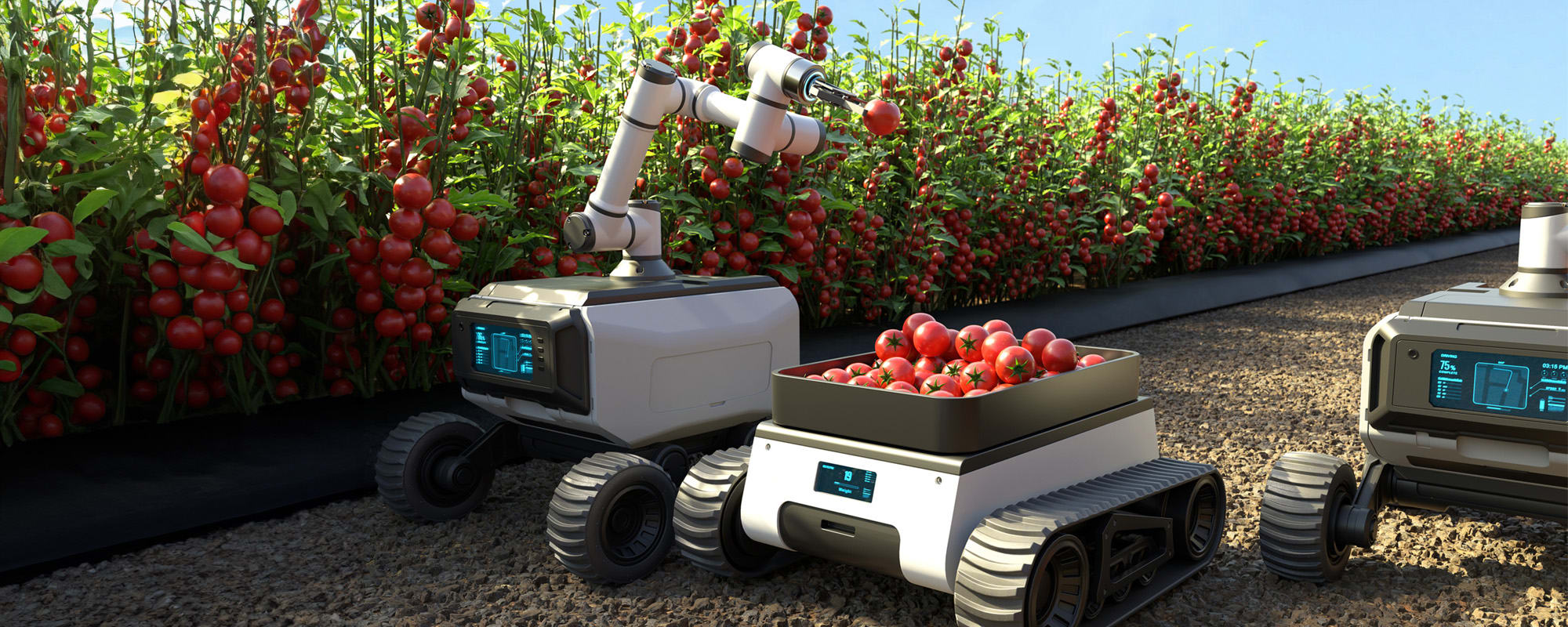Innovations in robotics are changing the world as we know it thanks to advancements in STEM fields ranging from electronic components to computer science. In honor of National Robotics Week, we’ve profiled eight cutting-edge robots bound to excite and inspire and shared links to additional information and activities you can use to celebrate with the young people in your life.

The rapid pace of evolution in the robotics industry over the last few decades has brought an abundance of impressive innovations into the mainstream. Sure, we aren’t all flying around on hoverboards like Marty McFly in “Back to the Future Part II” quite yet, but the advancements we have seen in recent years are astounding. For example, many of us have an autonomous robotic vacuum cleaner that reduces — if not eliminates — the amount of manual labor historically required to clean our floors, and now there are similar commercially available robots that mow lawns, clean pools, and clear snow. But that’s not all! In fact, consumer robotics advancements tend to pale in comparison to those in the industrial and
automotive markets. A growing number of factories and warehouses employ collaborative industrial robots engineered to improve the accuracy, efficiency, safety, and speed of a variety of operations while working seamlessly alongside human employees, and — despite not yet being commercially available — AI-enabled autonomous vehicle technology is effectively turning cars into robots.
While it’s undeniably cool to engage with more robotics as a consumer and to watch the robotics industry expand and evolve, it’s also an especially exciting time to be savvy in the STEM space. Advancements in technologies across several STEM disciplines, including electronic components, like sensors and advanced chips, and computer science, like generative AI and machine learning, are fueling rapid growth in the robotics industry and heralding a paradigm shift in the world as we know it. For instance, generative AI is imbuing robots with the ability to generate diverse and creative behaviors and adapt to changing situations, as well as helping engineers fine-tune robotic hand designs capable of handling both heavy and fragile objects, and machine learning is enhancing robotic perception, decision-making, and control capabilities. Each of these powerful technologies is essential to the continued evolution of the robotics industry and responsible for the incredible impact that these transformative technologies increasingly have on various aspects of human life.
To celebrate the exponential evolution and wide-ranging impact of the robotics industry and ensure its continued success, iRobot — the American robotics company founded by three members of MIT’s Artificial Intelligence Lab and responsible for inventing robots ranging from the Roomba robot vacuum to PackBots used to assist with bomb disposal and nuclear disasters and the SeaGlider used to assist with the Deepwater Horizon oil spill — encouraged Congress to establish National Robotics Week. Congress obliged in 2009, designating the second week of every April as National Robotics Week in order to inspire students to pursue robotics and STEM-related fields, promote the U.S. robotics industry, advocate for robotics research, educate the community, and share the excitement of robotics with audiences of all ages.
National Robotics Week 2024, which runs from April 6–14, marks the 15th annual event. In celebration, we’re highlighting eight of the most cutting-edge robotics technologies showcased at CES 2024 and Automate 2023, along with some of their enabling technologies, in hopes of getting young minds excited about the future of robotics and inspiring them to help shape it by getting involved in STEM.
Autonomous Consumer Robots
With global car-crash-related deaths in the millions each year, self-driving cars are likely the flagship of any autonomous robotics conversation in the consumer space. While we are still a ways off from commercially available Level 4 or Level 5 self-driving vehicles, several brands have released vehicles with Level 2 (Tesla, for example) and Level 3 autonomous technology and are actively setting the stage for a fully autonomous future. And that momentum certainly picked up at CES 2024, where Kia, part of the Hyundai Motor Group, debuted its new Platform Beyond Vehicle (PBV) lineup of modular EVs and Amazon showcased its Zoox robotaxi and announced that it would start providing public rides after more than six years of testing.

KIA’s new PBVs will be available in three models, one of which, the Kia Concept PV5 scalable people mover and mobile workshop, is also being developed as a driverless robotaxi. This vehicle will offer three different body styles — a passenger model, a delivery van, and a flexible chassis cab utility vehicle designed for further customization — to suit a wide variety of urban passenger and cargo transportation needs, and it will eventually be imbued with Motional’s advanced Level 4 autonomous driving technology, which employs a variety of high-tech cameras, radar and LiDAR sensors, onboard computing systems, and AI to ensure safe operation. Manually operated PV5 PBVs are scheduled for release in 2025, but there’s not yet any indication of when the robotaxi version will hit the streets.
To see Level 3 autonomous driving technology in action, head to Las Vegas where, later this year, you can catch a ride around a one-mile loop in one of Amazon’s Zoox autonomous taxis, which are designed to reduce congestion in urban areas and minimize commuter collisions. These driverless vehicles use an extensive array of sensors, cameras, and radar and LiDAR technologies to provide an overlapping 360° view of its surroundings and see more than 150m away in all directions. They also have a powerful computing system with redundant backups that run proprietary software and leverage AI software to provide comprehensive, real-time knowledge about its environment and exhibit predictive, safety-first reactions in volatile traffic conditions. To see them in action now, watch this Zoox safely merge into multi-lane Las Vegas traffic and this one navigate through the notoriously tricky streets of San Francisco.


Advances in consumer robotics aren’t limited to cars, though. Robotics are increasingly making other everyday activities quicker, easier, and more autonomous as well, like lawn care for instance. Some of us love lawn care and maintenance. For others, it’s a chore that eats up valuable time and aggravates allergies. Those of us in the latter group will be happy to learn about the Yarbo Modular Yard Robot, which was showcased a CES 2024 and is already available for purchase. The Yarbo uses sophisticated sensor systems, real-time kinematic positioning GPS, and three different computer vision cameras to perceive and traverse its environment with impeccable precision. These advanced technologies make up its Precise Positioning Vision System (PPVS), which allows it to operate within virtual boundaries and parameters you can manage with a mobile app. It also sports a modular design that delivers added value and functionality and shows off advancements in robotic design and engineering. Its treads can handle rough terrain, and its chassis can be fitted with a lawn mower, leaf blower, and a snow blower for efficient, autonomous, and effective year-round lawn care. Want to see the Yarbo in action? Watch it clear snow from a yard in Idaho.
Autonomous Industrial Robots
Robots and cobots have been employed in the industrial sector for some time, and as these technologies continue to evolve, they provide an ever-expanding array of valuable industry advantages. For example, industrial robotics enable tremendous improvements in safety, efficiency, productivity, quality, consistency, flexibility, scalability, resource management, and competitiveness. They also help reduce operating costs through both precision and availability and maximize space compared to bulkier machinery. And while industrial robotics are still relatively expensive, the ROI tends to more than justify the upfront costs.
The Stäubli PF3 Automated Guided Vehicle (AGV) Platform was introduced at Automate 2023, where it won the Best Smart Product Award in the prestigious Red Dot Design competition, and is an excellent example of high-ROI industrial robotics. The PF3 AGV features an impressive three-ton payload capacity and accessories including American and European pallet stations, a table attachment, and a rugged remote control ideal for industrial interlogistics, assembly line, and pallet transport applications. It glides around busy factory floors and warehouses carrying heavy goods to their destinations, eliminating the labor and risk associated with manually hauling heavy things, and completing that work much faster and more efficiently. Laser scanners at its front and rear are equipped with three-dimensional vision monitoring, which helps the PF3 perceive its environment and identify where objects are located relative to its position and gives it a 360° field of view to ensure the safety of humans, machines, and equipment in its proximity. In addition, since safety is obviously paramount when it comes to industrial equipment of all kinds, it also features five emergency stop buttons.

Industrial robotics technology is breaking into the infrastructure and construction markets too. HD Hyundai had CES 2024 attendees craning their necks to marvel at the futuristic boom arm and digging claw springing out of tank-like treads of its Xite excavator, which, while still in the prototype stage, gave attendees a glimpse of another application for industrial robots in the workplace, as well as for EVs. The fully electric and autonomous Xite prototype is equipped with a cab-less chassis and an array of sensors and cameras that allow it to see its surroundings and the materials it carries in its claw. Autonomous construction robots like this definitely have the potential to spark new job security concerns, but they could also help solve widespread skilled labor shortages and decarbonize the construction industry.


Industrial manufacturers are also looking to solve chronic labor shortages with advanced robotics — specifically, AI-enabled humanoid robots. And while these can certainly be a bit unsettling, if this news has you conjuring up dystopian images of “The Terminator” or “The Matrix,” consider that the goal of these humanoid robots is to fill impactful gaps in the industrial labor market and create safer industrial facilities that pose fewer risks to humans. Figure’s new 01 robot is an incredibly adept example of humanoid robots. Figure 01 is designed to open doors, carry boxes, and engage in menial tasks with both full autonomy and the astonishing ability to self-correct thanks to an array of enabling technologies, including advanced sensors, software, and screens. Need to see it to believe it? Check out this video of Figure 01 pouring its engineer a coffee.
Figure has recently secured backing from tech titans like Microsoft, NVIDIA, Open-AI (creator of the renowned Chat-GPT), Intel, and Amazon tycoon Jeff Bezos, but it isn’t the only player in this novel humanoid robot landscape. Agility Robotics, Boston Dynamics, and even Tesla are also developing autonomous androids, and if the case for humanoid robots in manufacturing continues to grow, there are sure to be more innovators to come.
Robotic technologies are also increasingly being used to improve humans’ health, wellness, and quality of life. While robots aren’t new to healthcare — Da Vinci robotic surgical systems, for instance, have been in use since 2000 — they’re now playing a broader role in the health and wellness industry. The WIRobotics’ We Innovate Mobility (WIM) is just one example that was showcased at CES 2024, where it earned Innovation Awards in both the Robotics and the Accessibility and Ageing Tech categories. This wearable, ergonomic, minimalistic, and lightweight (roughly just three-pound) robot is engineered to assist people with walking, jogging, and running. It combines biomechanical principles with advanced technologies, including torque and capacitive-force sensors and AI, to analyze wearers’ gait and their interaction with the terrain and provide added stability or safe and powerful assistance as needed. Applications for the WIM include reducing muscle fatigue for recreational or occupational purposes, adding resistance to aerobic exercise, and assisting in physical rehabilitation efforts to reduce hospitalization and improve patient outcomes. It can also leverage the data it gleans from wearers to provide personalized workout recommendations. To see the WIM in action, check out this video.


Health and wellness robots are also expanding their utility beyond the realms of improving physical health as societies around the world embrace mental health and wellness. Embodied, Inc. showcased its AI-driven “learning robot with heart,” the Moxie Robot, at CES 2024. Designed to interact with children to help improve their educational and emotional development, this small (14 x 12 x 4”), stationary robot has a friendly, cartoonishly animated faceplate and moveable arms that it uses to gesture at its companions for added engagement. Moxie is equipped with microphones, speakers, a camera, and sensors that allow it to interact with its surroundings, and it employs proprietary SocialX software developed by a team of Embodied technologists, child development specialists, and storytellers with experience at Disney and the Jim Henson Company to support holistic skill development for children ages five to 10. Its advanced conversational capabilities give children a safe, judgement-free space to learn and practice communication skills, and it also teaches children how to analyze, identify, and manage their emotions, take turns, and establish eye contact through learning modules and games.
Plus, the Moxie app for parents allows them to moderate their children’s engagement and adjust the affirmations Moxie provides based on their needs. The idea of AI-driven robots taking a greater role in child development is admittedly a bit bizarre, but they’ve been on the market since 2020 and have a host of reviews praising their positive impact. So, this is likely to be another growth segment in the rapidly expanding robotics market. Want to see this emotionally intelligent robot in action? Check out this video.
Fueling the Continued Evolution of Robotics
These eight robots are just the proverbial tip of the iceberg regarding groundbreaking robotics technologies. The world of robotics is an ever-evolving landscape that is growing exponentially, and none of it would be possible without the people working in other STEM disciplines, including computer science, engineering, machine learning, coding, and programming, which means that there’s a multitude of ways to get involved in the robotics industry, contribute to these exciting innovations, and help shape the countless ways they’re revolutionizing life as we know it. And as the demand for robots increases, the STEM job market, which is widely renowned for providing both financial stability and fulfillment, will continue to grow as well.
So, in honor of National Robotics Week, introduce some of these innovations and their wide-ranging impacts to the young people in your life, and ask them which kinds of robots they’re most excited about or hope to see in the future. If they show any interest, help or encourage them to check out the official National Robotics Week resources page, which offers educational information and activities for preschool to high school aged kids, including a pragmatic Guide to Robotics Research and Education for high school students and a craft activity, Build Your Own Beetlebot, for elementary school students. You can also introduce them to the FIRST Inspires global nonprofit organization dedicated to youth robotics programs, which hosts regular events centered around a community of passionate parents, students, and educators, or show them documentaries, like “NOVA Wonders: Can We Build a Brain?” and PBS’ “Me and My Robot,” both of which are streaming for free. And if you’re feeling creative, you could even build a cool robot with them.
Since National Robotics Week aims to increase awareness of, appreciation for, comfort around, and excitement about robotics, as well as encourage to young people to pursue robotics and STEM-related fields, there’s no wrong way to celebrate. So, just have fun!






